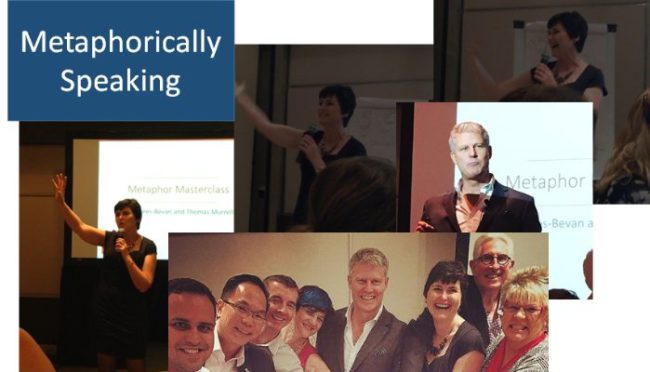If you've ever used the expression "Fish out of water" - you've used a metaphor!
In fact, most people use metaphors all the time without even realising it - think outside the box, have a lightbulb moment, go back to the drawing board, crack the whip, light your fire and so on. I tried to speak without using metaphors at all for a short while and found myself in the woods. Up a creek without a paddle. Wandering in the dark. I found it difficult!!
In speaking, we design metaphors to communicate our message more effectively. Sheryl Sandberg is a great example - in her TED talk "Why there are so few women leaders" she tells the story of women who enter the boardroom but sit at the outer edges of the room. Sheryl encourages them to "sit at the table." "Sit at the table" becomes her central metaphor for engagement and full commitment to work.
When I run Effective Meeting workshops, I tell the story of the mice who hold a meeting to decide how to outwit the cat. The mice decide to put a bell on the cat so they'll hear him coming when they're trying to steal cheese from the kitchen. The story ends with the question "Who will put the bell on the cat?" This becomes the metaphor during the workshop - "Who will put the bell on the cat?" Who is responsible for the action item?
The Stroke Foundation StrokeSafe ambassadors sometimes use the metaphor of the garden hose to explain how a stroke affects the brain. If there is a kink in the hose, the water doesn't get through and that part of the garden isn't watered. If there is a leak, part of the garden is flooded. The hose is a metaphor for the blood vessels in the brain.
The use of something simple and common to most people's experience clarifies a medical concept.
I often use the metaphor of climbing to convey the idea of speaking quality not being affected by nerves. I tell the story of going climbing and seeing climbers right up at the top of the rocks still using chalk dust and obviously battling with sweaty palms. Just because they're nervous, it doesn't mean they can't do well. They've reached great heights. This story functions as a metaphor to communicate to my workshop participants that just because they're nervous, it doesn't mean they won't speak well. But the wonderful thing about metaphors is that you don't need to explain that. People instinctively draw the connection and understand the parallel. Further than that, they get the implied metaphorical "heights" that they are capable of achieving.
Last weekend I had the privilege of working with Media and Communications expert Thomas Murrell on a Metaphor Masterclass for the Professional Speakers’ National Convention. Within the space of that workshop, some amazing metaphors were developed, demonstrating that it is well worth brainstorming some ideas to come up with creative and effective ways of cementing your message!
We use metaphors because they:
- Create connection (use a universal experience to explore common ground)
- Give clarity
- Create intrigue
- Make your message memorable (think of Sheryl Sandberg’s “Sit at the Table”)
- Crystallize your central idea without requiring explanation
Think about the subject matter of your talk. Can you make it more memorable, clear and interesting by using a metaphor?

